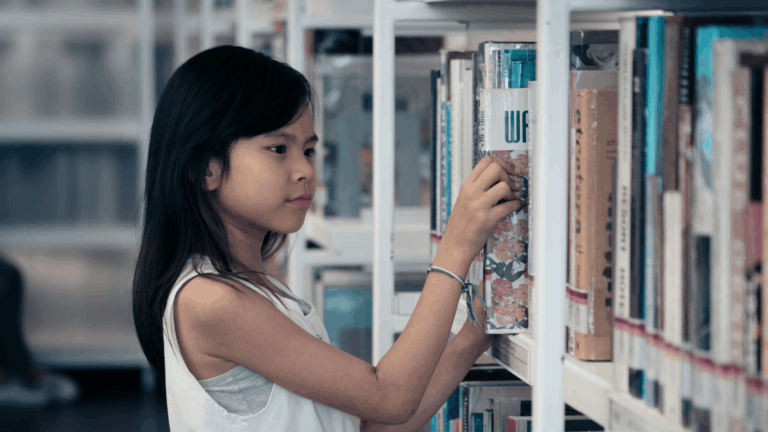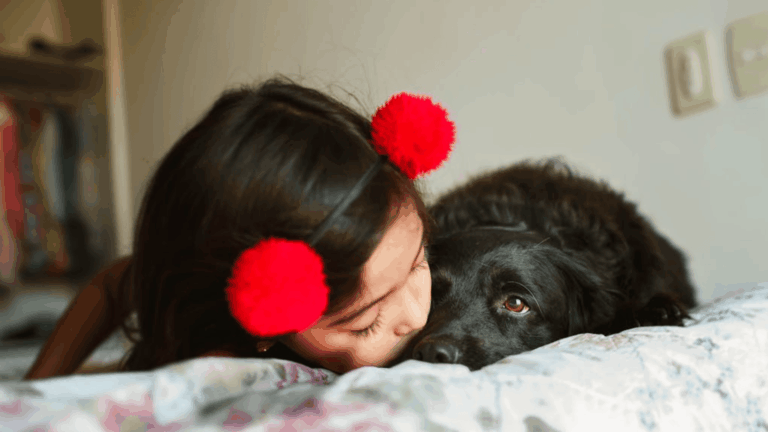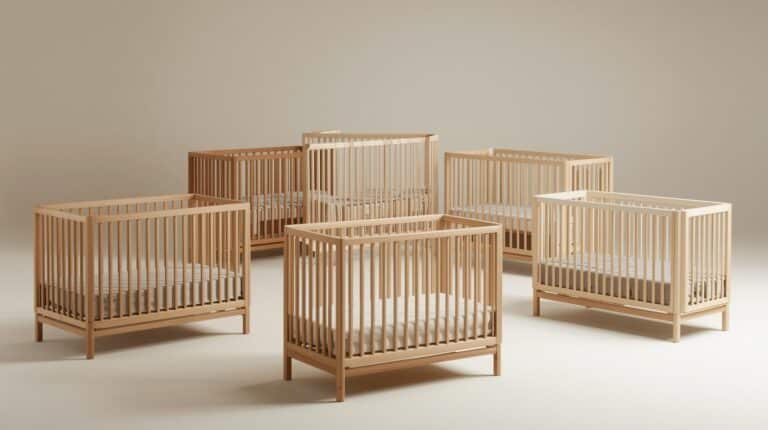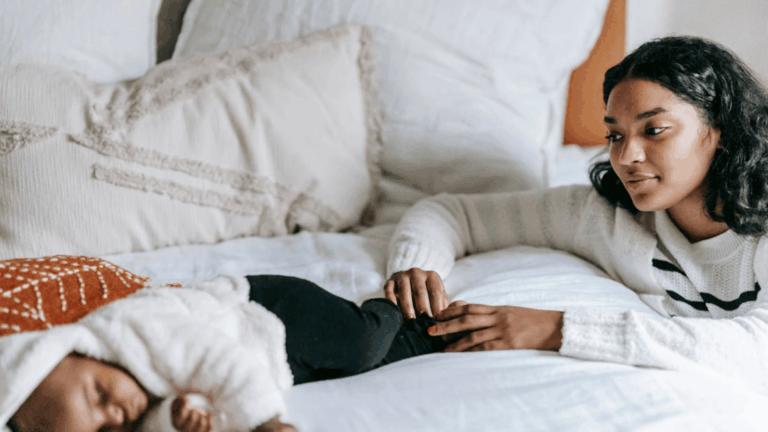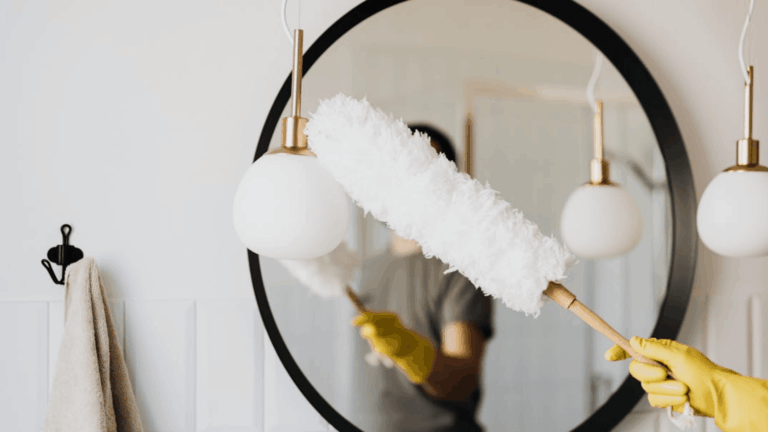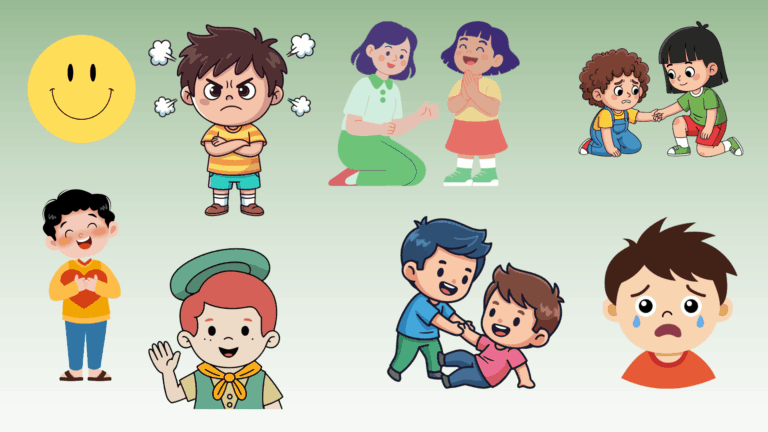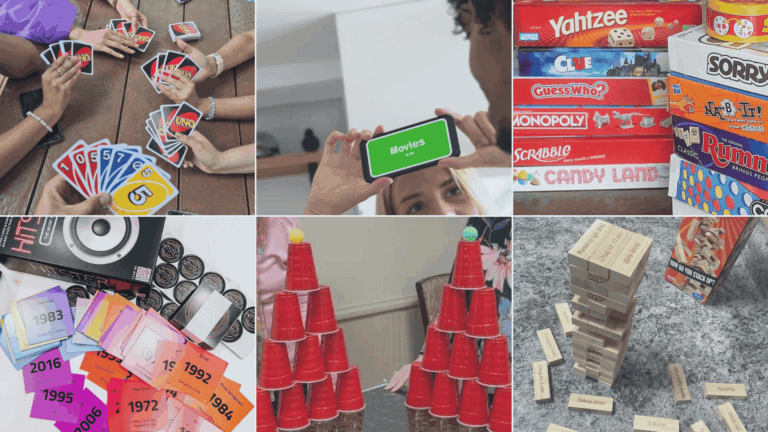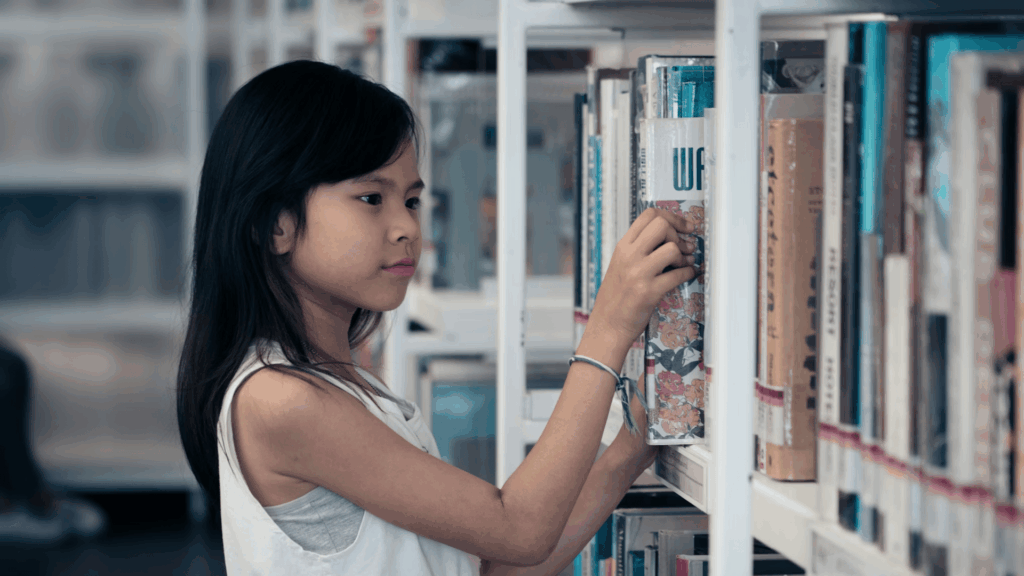Many children struggle to say “light” and “white” correctly. They might say “wight” for both words. This happens because they haven’t learned to tell these sounds apart yet.
Minimal pairs are word sets that differ by just one sound. Speech therapists use them to help children hear and say sounds clearly. The l and w minimal pairs are beneficial for kids who mix up these sounds a problem called gliding.
Did you know that 1 in 12 children has trouble with speech sounds? Let’s examine how minimal pairs can help address this issue.
Understanding L and W Minimal Pairs
L and W minimal pairs are sets of words that differ only by the initial /l/ or /w/ sound.
These pairs are important for helping children learn to hear, distinguish, and correctly produce these two sounds. Practicing minimal pairs supports clearer speech and better communication skills.
Many young children replace the /l/ sound with /w/ because the /w/ sound is easier to produce. This substitution is called “gliding.” It is a typical part of speech development in toddlers and usually improves by age 6.
However, some children, especially those with speech delays or disorders, may continue to swap these sounds longer.
They need focused practice with minimal pairs and targeted speech therapy to recognize and produce the correct sounds, helping them improve their speech clarity and confidence.
Common L and W Minimal Pair Words
| Nouns | Adjectives | Verbs |
|---|---|---|
| lake/wake | light/white | leap/weep |
| leaf/weave | low/wow | lick/wick |
| lamp/warp | late/wait | lie/why |
| lock/wok | loud/wood | lock/wok |
| lip/whip | lucky/wucky | lend/wend |
| leg/wag | little/whittle | load/woad* |
| line/wine | long/wrong | look/wok |
| lid/wit | lean/wean | lift/wift* |
| loaf/waif | limp/wimp | live/wive* |
| lawn/warn | lovely/wovely* | leave/weave |
Why These Categories Help:
Grouping words by type makes therapy sessions more focused. Therapists can work on nouns during picture-naming games. Action words work well with movement activities.
Practice Tip: Start with easier words like “light” and “white.” These sounds are clearer for children to hear. Then move to harder pairs like “lock” and “walk.”
Each pair gives children a chance to practice hearing the difference. The more they practice, the better they get at making both sounds correctly.
Engaging L and W Minimal Pairs Worksheets
These worksheet types help children practice the l and w sounds in fun ways. Each one targets different skills that build better speech.
1. Sound Discrimination Worksheet
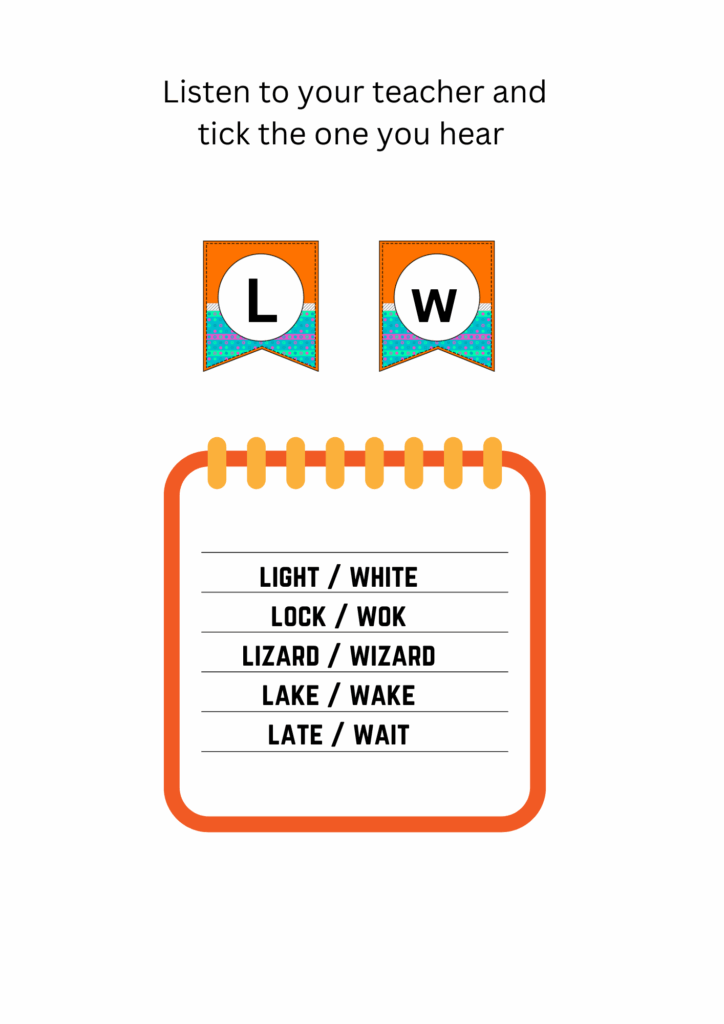
Listen carefully to each word you hear. Look at the pictures and decide which word matches the sound. Circle the picture that shows the word spoken.
Skills developed:
- Developing focused listening and attention to detail
- Distinguishing between similar speech sounds
- Enhancing auditory discrimination and phonemic awareness
Click here to download the PDF worksheets to practice these skills.
2. Picture Matching Worksheet
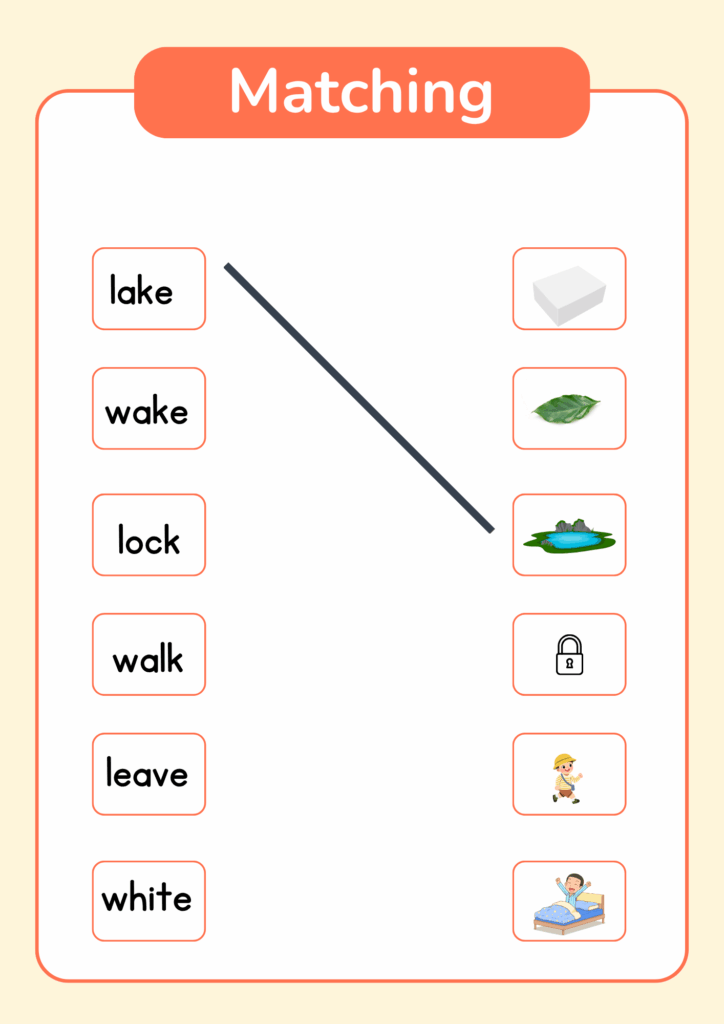
Listen as each word is spoken by your teacher. Carefully look at the pictures on your page and find the one that matches the word you heard. Draw a line to connect the word to its correct picture.
Skills developed:
- Strengthening word recognition through auditory and visual cues
- Developing visual processing and matching abilities
- Building connections between spoken language and images for comprehension
Click here to download the PDF worksheets to practice these skills.
3. Word Sorting Worksheet
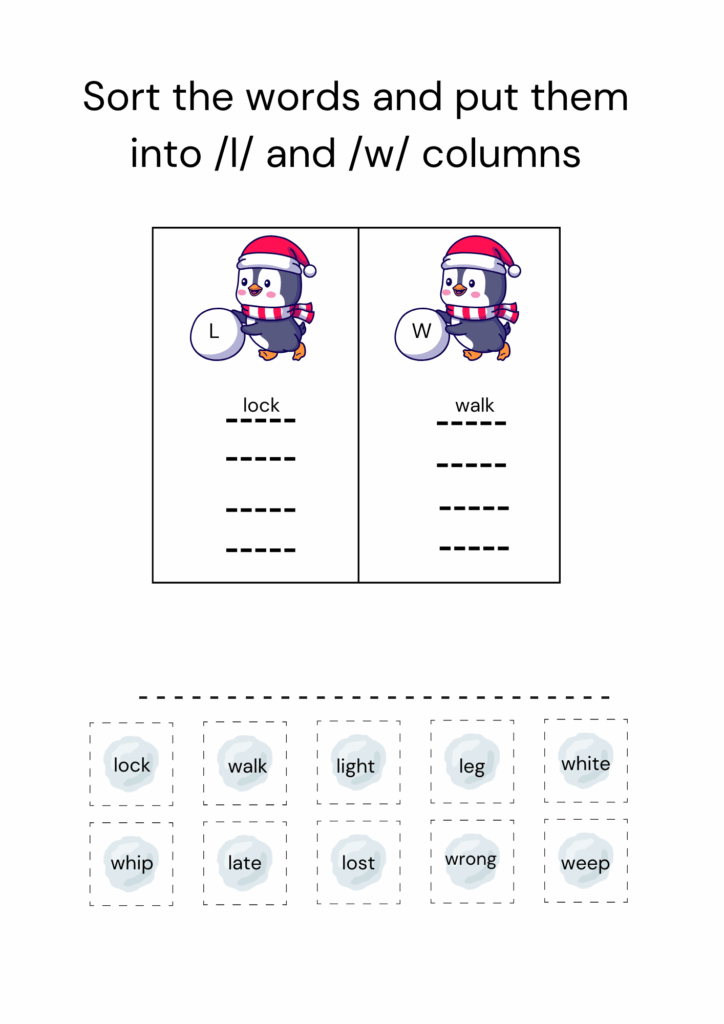
Look at each word card and say the word out loud. Listen carefully to the first sound in each word. Place the words in the correct column for /l/ or /w/ based on how they begin.
Skills developed:
- Strengthening sound categorization by identifying initial sounds in words
- Building phonetic awareness through sorting and comparison
- Practicing attentive listening and accurate word grouping based on beginning sounds
Click here to download the PDF worksheets to practice these skills.
4. Fill-in-the-Blank Worksheet
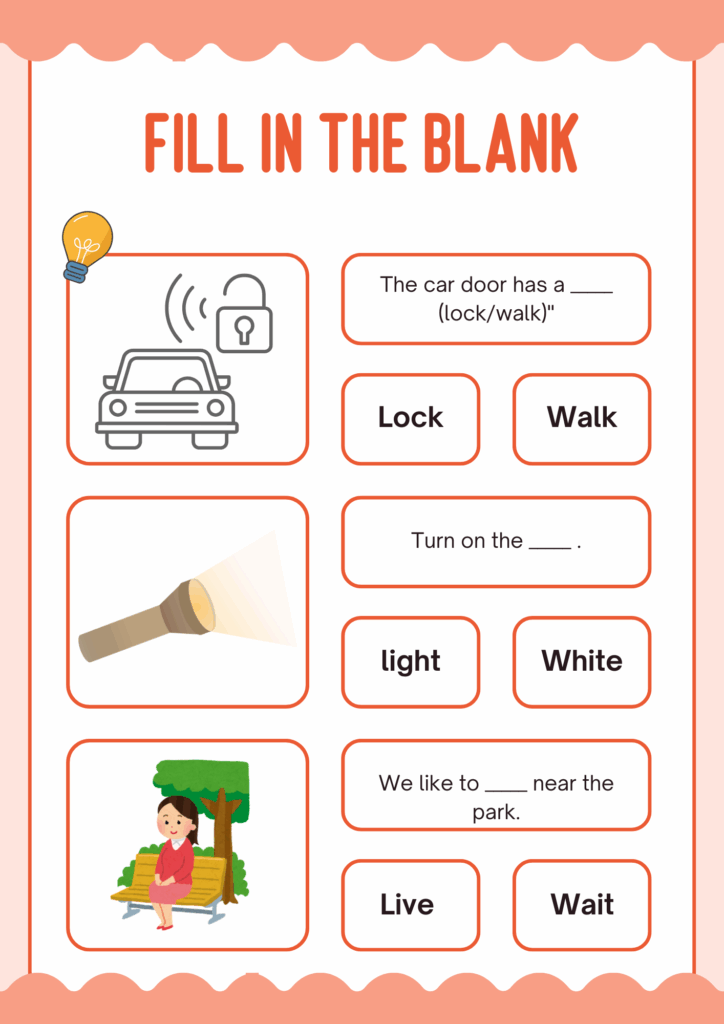
Read each sentence carefully and think about which word fits best. Write the word in the blank space to finish the sentence. Complete sentences by choosing the right word: e.g., “The car door has a _____ (lock/walk)” or “Turn on the _____ (light/white).”
Skills developed:
- Using context clues to understand sentence meaning
- Enhancing vocabulary and word recognition
- Improving comprehension of minimal pairs through sentence completion
Click here to download the PDF worksheets to practice these skills.
5. Read & Draw Worksheet
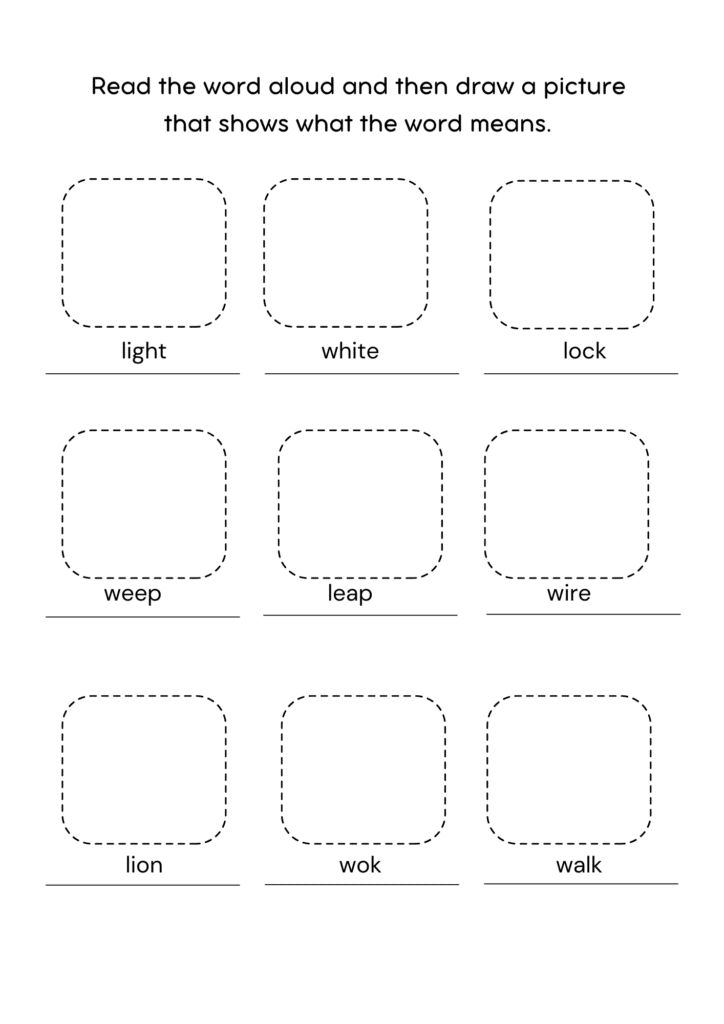
Task: Listen to the word your teacher says (e.g., “lake” or “wake”). Say the word aloud. Then, draw a quick picture of that word in the box provided.
Skills developed:
- Listening accuracy and initial sound awareness
- Verbal production of target sounds
- Creative representation and word meaning comprehension
Click here to download the PDF worksheets to practice these skills.
Speech Games that Make a Difference
Games turn speech practice into a fun time. Children learn faster when they enjoy what they’re doing. These five games help kids master the l and w sounds without feeling like work.
1. L vs W Memory Game
This classic card game uses minimal pair pictures instead of regular cards. Children flip two cards at a time, looking for matches like “light” and “white” pictures. When they find a pair, they must say both words clearly. The game builds memory skills while practicing sound differences. Kids love the challenge of remembering where cards are located.
2. Sound Sorting Boxes
Two boxes sit on the table – one marked with “L” and another with “W.” Children pick up picture cards or small toys and drop them in the correct box based on their starting sound. A toy lion goes in the L box, while a toy whale goes in the W box. This hands-on activity helps kids feel the difference between sounds through movement.
3. Flashcard Races
Fast-paced fun gets children excited about speech practice. The therapist holds up cards with l and w words. Kids race to name the picture or act out the word. “Lake” might mean pretending to swim, while “wake” could mean stretching and yawning. Speed adds excitement while repetition builds skill.
4. Guess the Word
The therapist says either “lip” or “whip” behind a barrier. Children must listen carefully and point to the correct picture. This game sharpens listening skills and helps kids notice small sound differences. Success builds confidence in their ability to hear these tricky sounds.
5. Sound Detective
Children become detectives hunting for target sounds in sentences. The therapist says, “I saw a white light in the lake.” Kids count how many l and w words they heard. This game teaches children to focus on sounds in natural speech, not just single words.
Tips for Practicing l and W Sounds
Make l and w minimal pairs sound practice part of everyday life by highlighting these words in conversations, stories, errands, and play, helping children build their skills naturally and confidently.
- Point out l and w words naturally during conversations, such as while making lunch (“let’s wash the lettuce”) or choosing a drink (“water or lemonade?”).
- Read books with lots of l and w words; let children spot these sounds as you read together.
- Turn shopping trips into speech games by finding items that start with l or w (like lemons or whole wheat bread).
- Encourage outdoor talk using l and w words (“look at the leaves,” “let’s walk to the swings”).
- During evening routines, have children name things they see such as lamps, windows, and walls.
To Conclude
L and W minimal pairs give children the tools they need for clearer speech. These simple word pairs help kids hear differences between sounds that once seemed impossible to tell apart.
Small daily practice sessions make big changes over time. When children master these sounds, they gain the confidence to speak up in class and chat with friends. Their communication skills grow stronger each day.
Speech therapy works best when families join the effort. Home practice, fun games, and patient encouragement all help children succeed. Every child can learn to say “light” and “white” clearly with the right support and practice.
Clear speech opens doors to better relationships and learning opportunities.





